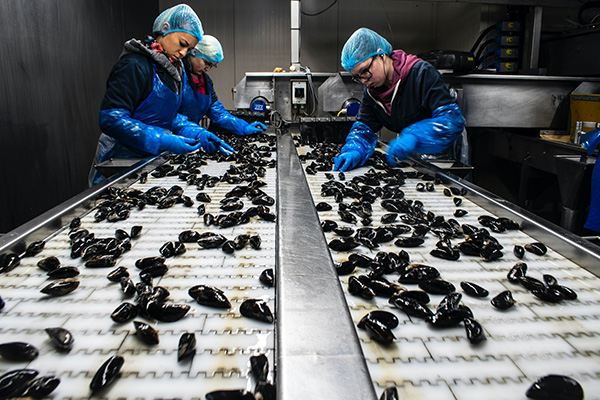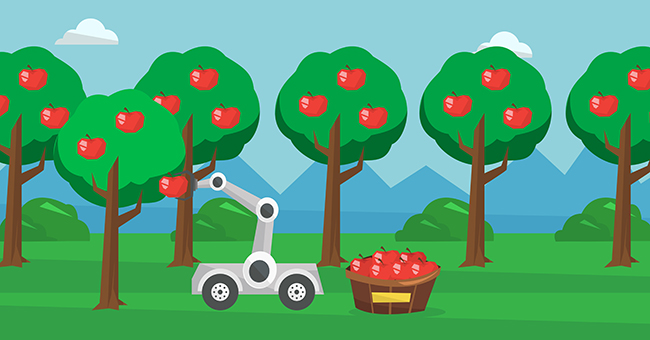Across industries, new innovations in robotics technologies are helping to speed up day-to-day work and improve product quality. Robots can be especially effective for businesses in the food processing industry, where a growing labor shortage poses trouble for processors.
While a number of critical industry tasks were difficult to fully or partially automate in the past, new robotics technology is helping to increase the number of potential applications for robots in the industry.
Consistency, Accuracy, and Speed
Food processing robots offer a few major advantages over conventional food processing workflows. Robots can perform a task repeatedly over the course of a work day or shift, typically with minimal deviation in precision. Unlike human workers, robots don’t get tired, and their pace of work tends to stay consistent. This combination of accuracy and speed has been found to increase site throughput while ensuring packaged products are up to company standards.
Food processors that adopt robots also see major gains in item consistency—more often, packaged products contain the same amount of food, weigh the same, and are packaged in the same manner.
Automated packaging systems can sometimes be a poor fit for certain food commodities, especially for products like delicate fruits and vegetables.
Experimentation, however, often leads to custom solutions that can handle these unique challenges. After experimentation with new weighing and packaging robots in the cannabis industry, for example, processors were able to accelerate the packaging process and create more consistently packaged items.
In the food processing industry, this can come in the form of robots with soft silicon grippers and attachments, which help companies package delicate products.

Preventing Cross Contamination
Despite improved food safety standards, foodborne disease outbreaks remain common in the United States.
The use of robots can help control cross-contamination in food processing plants.
With any human labor force comes the risk of cross-contamination. Workers assigned to packaging foods can easily transport pathogens from product to product or from one area of the facility to another. This is especially true in sites that process raw meat products. Even when following proper site hygiene practices, it’s possible for workers to unintentionally transport pathogens and other contaminants from one workcell to another.
Because work in food processing facilities is often shoulder-to-shoulder, it’s also easy for contaminants to spread from one worker to another once a particular cell has been contaminated.
Robots that are fixed in place and handle all the aspects of a particular packaging job can help localize potential contamination, making it easier for processors to minimize cross-contamination and keep food safe.
Robots can still contribute to cross contamination if not properly cleaned, but an additional set of robots could solve this problem, too. For example, one a provider of robots for the food processing industry has developed a set of robots capable of washing down an entire workcell.
These robots, working in pairs, activate at the end of each operating cycle and use high-powered jets of water to wash down the workcell, the packaging robots used there, and themselves.
Collaborative Robotics (Cobots)
One major recent innovation in robots has a new focus on tech that is collaborative.
These new robots, unlike conventional robotics, aren’t always built to fully automate a particular task. Instead, they are built to interact and work collaboratively alongside humans where necessary.
Artificial intelligence-based machine vision technology helps them navigate factory floors safely or assist in tasks like assembly and machine tending. Safety features like force limiters and padded joints help prevent injuries that can occur while working in close proximity to conventional robots.
These features also enable them to work in tight spaces without the use of safety cages that conventional robots sometimes require. In factories and food processing plants, they can provide assistance and speed up existing workflows.
For example, an article in Asia Pacific Food Industry cites one case study from a Swedish food processor, Orkla Foods. The company integrated cobots into a production line packaging vanilla cream, freeing up the human workers who had been responsible for the task. Before the cobots were introduced, workers had to bag and manually pack the vanilla cream into cartons.
Even with cobots, human workers are still necessary for tasks that require judgment, creativity, and problem-solving skills. Cobots can take over tasks that don’t lend themselves well to automation. These tasks tend to be tedious, dull, or even dangerous due to the repetitive motions workers need to make.
Even if a task can’t be fully automated, cobots can still help improve efficiency and boost accuracy. These robots provide the most significant benefits for businesses that need flexibility and agility in production.
Cobots are often lightweight and easy to reprogram on-the-fly, allowing workers to quickly move them from task to task as needed. In many cases, an entire fleet of cobots can be repositioned and reprogrammed in half a day, allowing a business to reconfigure its robots to handle entirely new tasks without additional capital investment.
This flexibility can also make cobots a better fit for personalized products than other systems. As product specifications change, a cobot can be easily programmed and reprogrammed to handle the differences.
The use of these robots can also help prevent cross contamination, like more conventional robotics.
Sector-Specific Applications
A handful of sectors within the food processing industry can also benefit from niche robotics designed to automate certain specific tasks.
Danish robotics manufacturer Varo, for example, developed a line of cake decorating and filling robots. These robots are designed with technology that allows them to determine which cake will be decorated next, minimizing the amount of human involvement needed to operate.
While these robots won’t be useful for every manufacturer, they are a good example of how many sectors within the industry stand to benefit from robots that can automate niche tasks.
Using Food Processing Robots to Improve Product Quality and Consistency
Robots help automate tasks that are dull, dirty or dangerous. In doing so, they typically provide businesses with significant upgrades to process accuracy, speed, and consistency.
New technology—like machine vision and collaborative robotics technology—is helping to expand the use cases of robots in the food processing industry. These robots can often improve product quality more effectively than process changes alone, and may help manage a labor gap that could persist well into the future.











